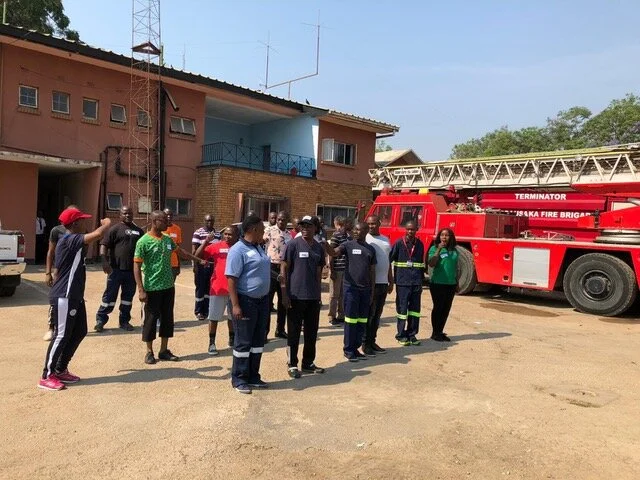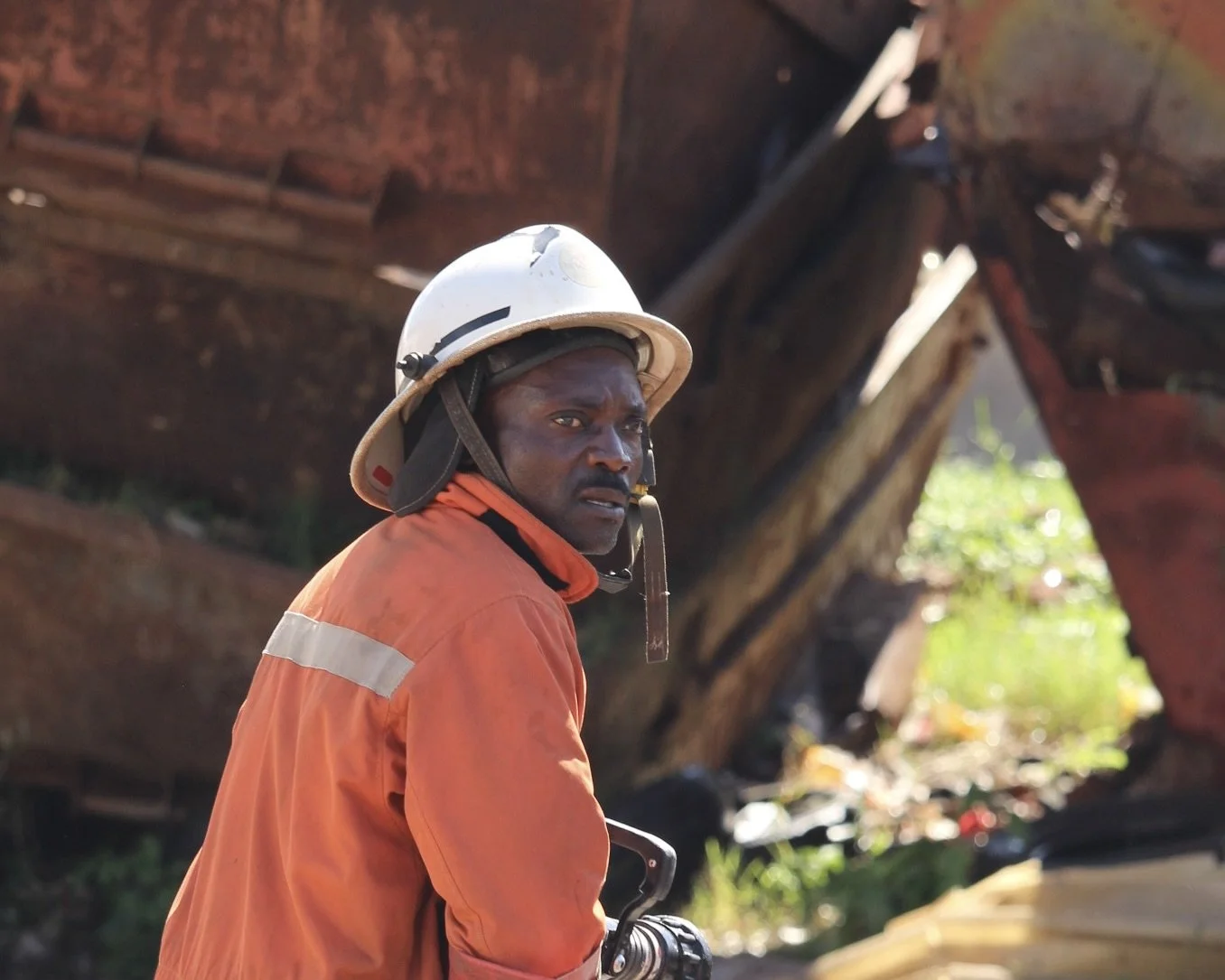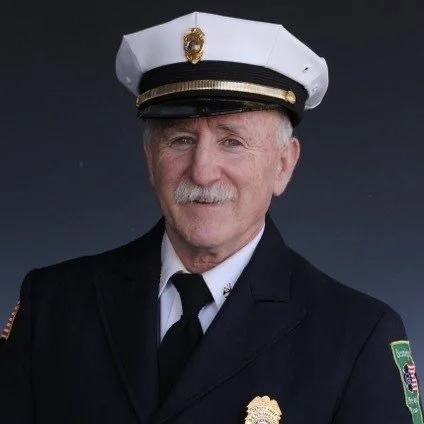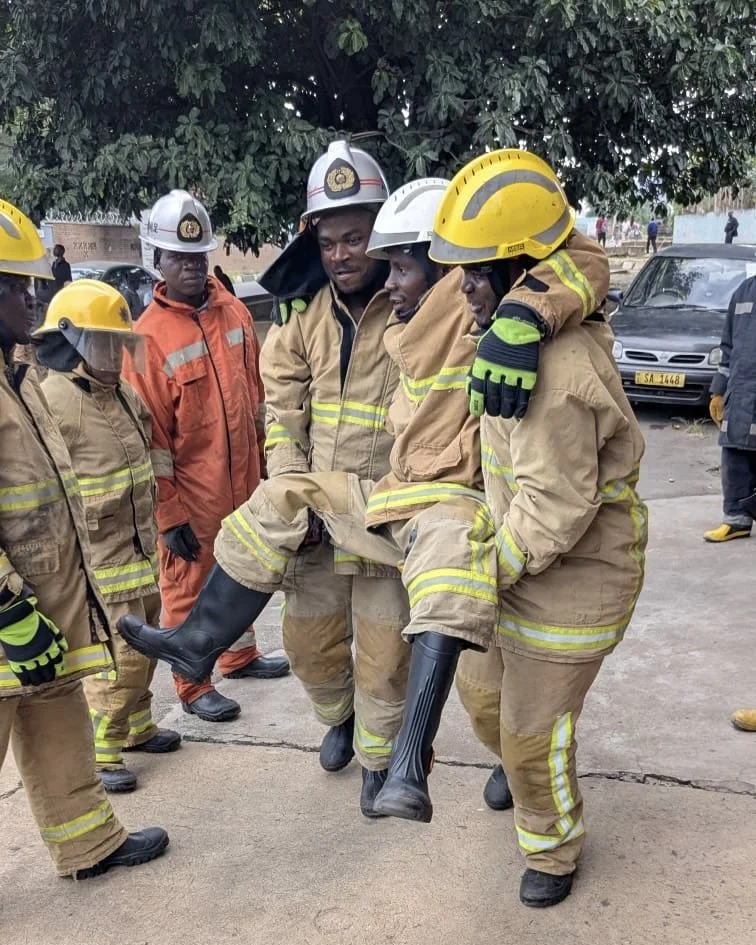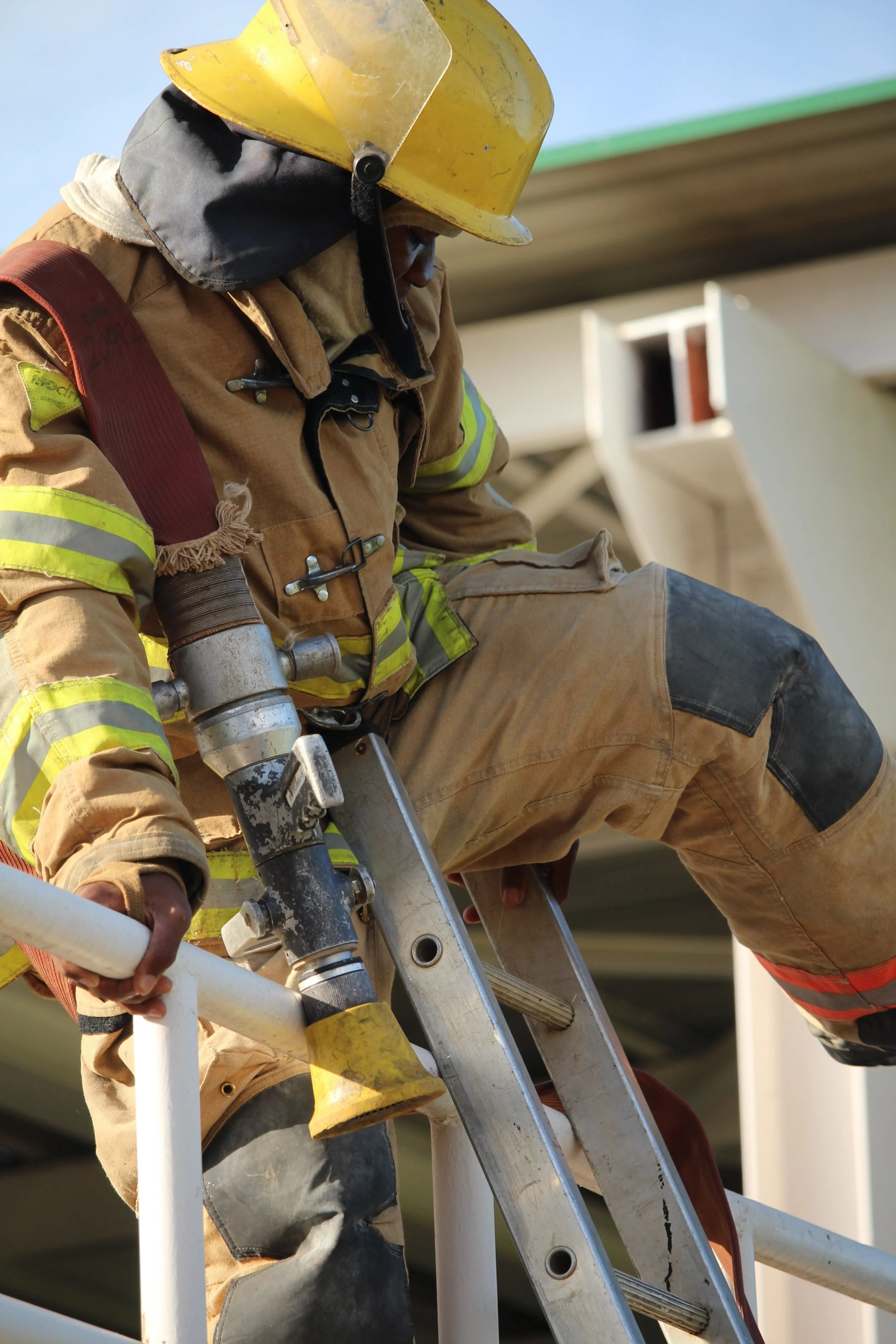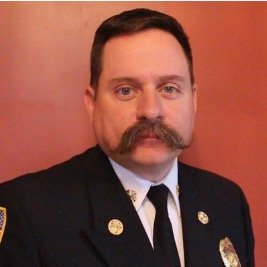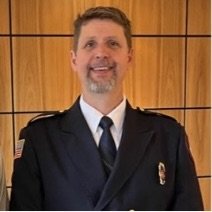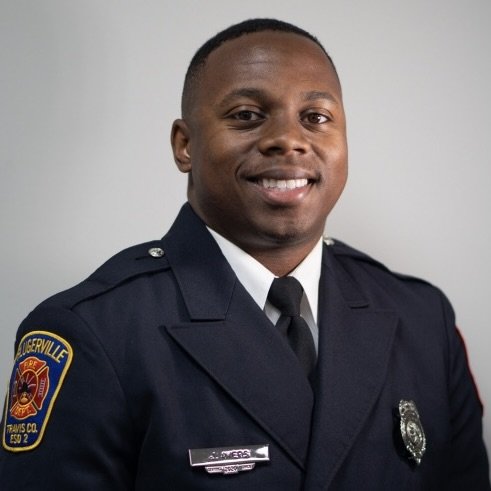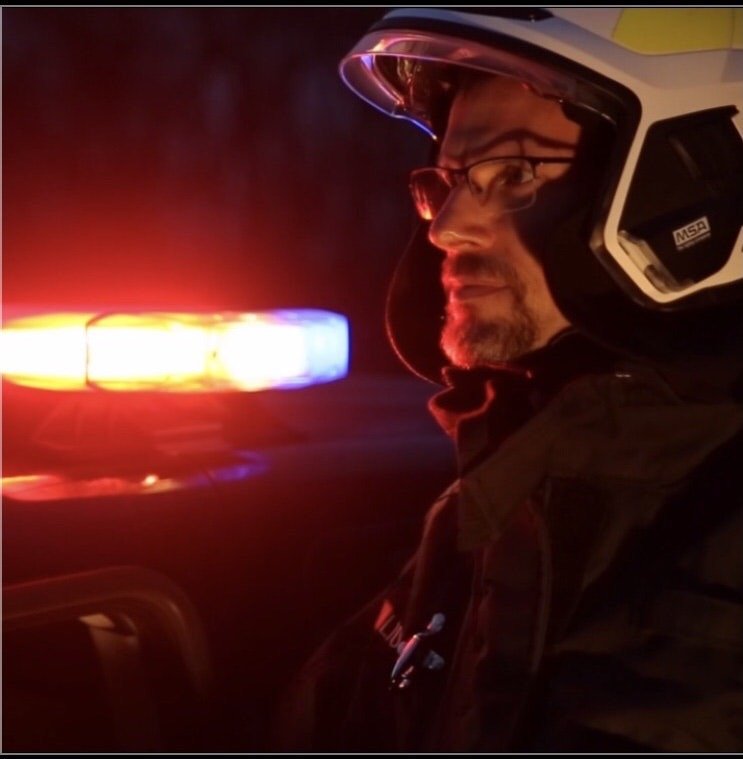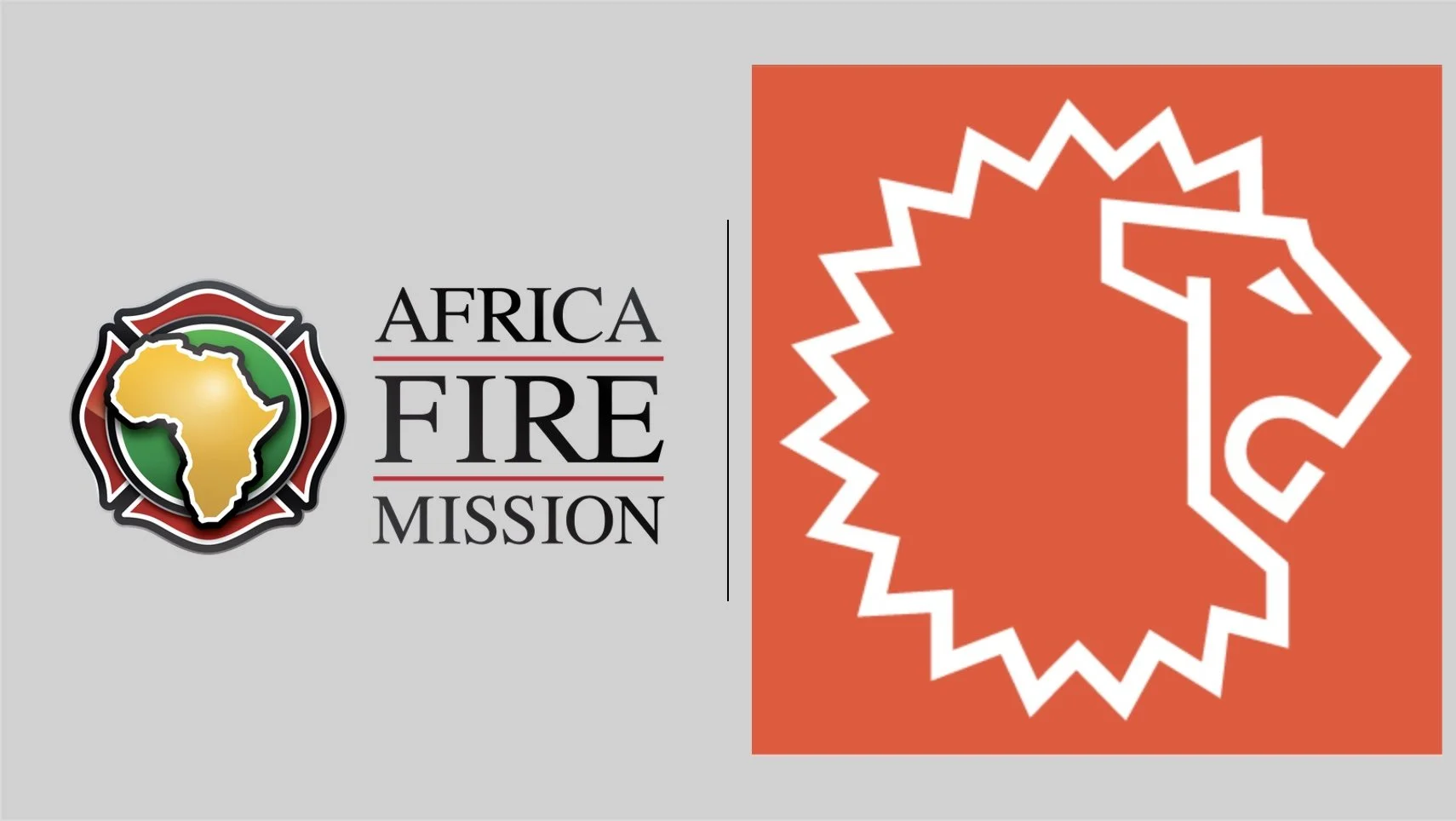We would like to recognize the different award winners from this year’s symposium to highlight the ever-growing fire service in Africa and the determination of first responders in Kenya and beyond.
Gas Cylinder Care
Gas cylinder care is a vital topic in communities that rely on these devices for cooking or other purposes. AFM’s staff team in Kenya, including Fire Safety Officer José Ngunjiri and Fire Safety Advocate Errol Sianga, regularly perform gas cylinder safety lessons in local communities. Now, you can access an official, professional recording of this training on our YouTube page! Whether you are a community member that relies on gas cylinders or you are a fire prevention instructor looking to further your understanding on the topic, please access the video below and watch the full lesson to help prevent deadly fires or explosions from gas cylinders.
Gas Cylinder Care Tips
Before using a gas cylinder, there are two steps you should always keep in mind:
Check the quality of your regulator. It needs to as clean as possible.
Take time connecting the regulator. Check to see if it is leaking or if there is any visible damage.
If a gas cylinder catches fire and starts to get out of control, remember to never throw your gas cylinder under any circumstances. If there is a fire that is starting to get out of control, take a solid, empty bucket and place it on top of the cylinder to create a vacuum, cutting off the air to the fire. Count slowly to five, then carefully remove the bucket away from you and turn off the cylinder. You can also drape a wet blanket and wrap the fire and cylinder completely. Again, count to five, then open it away from you and turn off the cylinder.
Kindly share this post and the video training with your communities to spread awareness on gas cylinder care.
Highlighting the 2025 Kenya EMS & Fire Symposium and Competition
The Impact of Leadership Training on County Fire and EMS Services
“The 2025 Fire and EMS Symposium at Bandari Academy in Mombasa provided an excellent platform for counties across Kenya to strengthen their emergency response capacity. As an instructor in the leadership class, I witnessed the dedication of Kenya’s firefighters and paramedics first-hand and saw the critical need for strong, ethical, and modern leadership within the sector.”
Suleiman Adan Issack, Chief Fire Officer of Mandera County, writes about his experience at the 2025 Kenya Symposium
Fire Scene
The topic Fire Scene carries many connotations or sub-topics. Today’s supporting sub-topics are communication, coordination and control. When utilized consistently, the outcome is most often effective fire scene command. The commander must master and rely on these three skills to support fire and rescue operation efforts whether at single-family dwelling fires or large, commercial incidents.
Situational Awareness
As firefighters, we face numerous visible and hidden threats both on our way to the fireground and after we arrive. It is important for us to develop our situational awareness skills to help us identify the hazards and minimize risks to ourselves and the public. Furthermore, maintaining situational awareness enhances decision-making under pressure and fosters more effective responses in various situations, such as fighting a fire, rescuing a victim, or driving to a fire scene.
The OODA Loop
The OODA Loop, created by Air Force fighter pilot and military strategist John Boyd, is an excellent decision-making framework that consists of four steps: Observe, Orient, Decide, and Act.
- Observe: This step focuses on what is commonly called situational awareness. It involves making and recording observations.
- Orient: Observations are placed in context to understand the overall situation.
- Decide: Take the results of the orientation and observation steps and formulate the optimal course of action.
- Act: Execute on your decision without delay
The OODA loop helps us remain calm and relaxed during stressful situations, reducing tension and stress and improving everyone's ability to perform their tasks. It is also very helpful for preventing tunnel vision, one of the most dangerous pitfalls on the foreground. Tunnel vision occurs when stress and nerves narrow our focus, causing us to concentrate only on what is immediately in front of us. This lack of peripheral awareness can be deadly.
It is important to develop the habit of instinctively using the OODA loop. Practice it around the firehouse and even at minor calls. As you develop your observation skills, learn to use more than your sight. Paying attention to sounds and smells can teach us crucial fire information.
A firefighter checks his surroundings while training with a firehose.
Communication
Another important situational tool is communication. It is critical that we maintain constant communication with our team on the fireground. We need to inform our commanders and officers of our planned actions. For instance, if a window needs to be broken for ventilation, we must communicate this so that team members below can be aware of any falling glass.
Situational awareness is critical for first responders. We often must make quick decisions in high-pressure, high-stakes environments. By enhancing our situational awareness, we can make more informed decisions that help us stay alert and safe on the fireground.
Howard A. Cohen was a volunteer firefighter for 20 years. He began his firefighting career as a chaplain and retired as the deputy chief. He is currently AFM’s online program content director. He frequently presents for the Wednesday Webinars and contributes to the AFM blog.
An Introduction to the Principles of Emergency First Aid for Firefighters
by Howard Cohen
Not all firefighters are emergency medical technicians or paramedics, but we often serve as the first responders at scenes requiring life-saving first aid. Therefore, it is vital for all firefighters to possess at least a basic understanding of first aid. This short article aims to outline foundational principles for addressing trauma in situations where immediate life-saving medical assistance is needed. This article should not be seen as comprehensive first aid training. Nevertheless, with the basic and limited information provided here, and without any formal training, you may still have the opportunity to save someone’s life.
Scene Survey: The First Task
Size up: Regardless of your level of technical first aid training or medical knowledge, your first task when responding to an incident involving injuries is to gather as much information as possible about the situation. This is achieved through a thorough size up. It is crucial to assess the risks and dangers before rushing in to provide aid. Ask yourself, “What is trying to kill or harm me?” Is it traffic, wildlife, fire, an unstable building, falling objects, or floodwaters? You do not want to become another casualty or cause further harm to the patient.
Number of patients: Once you’ve ensured the scene is safe and stable, it’s time to determine how many individuals are involved in the incident. It’s easy to focus on patients who are crying out in pain and overlook those who are unconscious or not visible. Additionally, it can be tempting to rush to assist a person whose injuries seem more life-threatening than they actually are, such as someone bleeding from a superficial head injury, while another individual nearby has stopped breathing.
Primary Survey: The Second Task
The primary survey is an assessment of the three essential life-supporting functions: the respiratory, circulatory, and nervous systems, often called the ABCDs. Any problems related to these systems present an immediate risk to the patient's life and must be addressed without delay.
ABCDs: Once the size-up is completed, the scene is safe (or as safe as you can make it), and you have a sense of the number of patients needing aid, initiate a primary survey of the patients by checking the status of the three conditions that represent an immediate threat to life.
Airway: Check to make sure that the mouth and airway are cleared and that air is actually going in and out.
Blood is circulating: Ensure that blood is not spilling out and that it is actively circulating.
Disabled: Check whether the spine is stable and the central nervous system is functioning normally. Due to the limited scope of this article, I will not discuss further injuries related to the head, neck, or spine.
Active Bleeding Control Instructor checks the pulse and applies bandages to a patient.
Basic Life Support (BLS)
Basic life support (BLS) is the immediate treatment of one of the three life-threatening emergencies found during your primary survey. Its purpose is to provide temporary support to keep the patient alive while a secondary survey is conducted and/or until advanced treatment is available.
The simplest way to begin a primary survey is to ask the patient, “How are you?” If he answers, you know that his airway is not obstructed (A), his heart is beating (B & C), and his brain is functioning (D). If the patient does not respond or responds in an unusual way, you will need to look more closely.
Airway:
Airway problems result from an obstruction to the pharynx or larynx, which can be complete or partial. A complete obstruction is rapidly fatal, but it can be effectively and dramatically treated by clearing the airway. There are various ways an airway can become obstructed, such as vomit, a foreign object, swelling caused by trauma, an irritant, or an allergic reaction. It is imperative that you clear the airway, but you must do so without causing any additional harm to the patient.
Breathing:
A person can have an open airway yet still experience difficulty breathing. This may result from an injury to the brain, spinal cord, or diaphragm. The method for assisting a patient with breathing when more advanced medical care is unavailable is known as positive pressure ventilation or artificial respiration (mouth-to-mouth). The inflation rate should be around 12 breaths per minute or one every 5 seconds, with each breath lasting about 1 to 1.5 seconds. Rapid breaths can push air into the stomach, potentially leading to vomiting.
Bleeding & Circulation:
Uninterrupted blood circulation is essential for survival. There are two primary types of disruptions to blood circulation that a first responder can address: cardiac arrest and bleeding. Cardiac arrest occurs when the heart stops beating. During your primary survey, if you discover that the patient has no pulse, it indicates that her heart has stopped beating, and she is in cardiac arrest. It's important to note that in adverse situations, or if the patient is in shock, finding a pulse can be challenging. The carotid pulse is the strongest and easiest to access; it is located on either side of the larynx in the neck. If there is no carotid pulse, the heart is not beating. CPR (cardiopulmonary resuscitation) is the only treatment for cardiac arrest. Even with hands-on training, it has limited potential to restore and sustain life.
The second type of disruption to circulation results from significant blood loss. Controlling blood loss is essential as part of BLS. Bleeding can be internal, which is often difficult to identify and stop, or external, though it may not always be obvious. Addressing internal bleeding goes beyond the scope of this article and the capabilities of most first responders in the field. External bleeding is managed by applying direct pressure to the bleeding site with your hand, ideally using a cloth or bandage. This application is not intended to absorb the blood; instead, it provides uniform pressure across the wound. Prepare to maintain direct pressure for ten minutes or more. If the bleeding does not stop, remove the bandage to locate the source of the blood and then reposition your hand.
There is no easy rule for determining when bleeding is severe. A rule of thumb is that if it looks like a lot of blood, it probably is. However, severe bleeding can be missed if the patient is wearing a lot of clothing or the blood is absorbed into the ground around the patient.
Conclusion:
Firefighters practice safely transporting an injured person.
When developing first aid skills, like all skills a firefighter must master, training and practice are essential. Additionally, reading about the principles and theories that support these skills is important. However, there is no substitute for training and practice.
For more information, visit the following references:
Africa Fire Mission Active Bleeding Control Resources
The Outward Bound Wilderness First-Aid Handbook; Jeff Isaac & Peter Goth.
The Field Guide of Wilderness & Rescue Medicine; Jim Morrissey & David Johnson.
Opening an Unconscious Patient’s Airway with a Manual Manipulation
Howard A. Cohen was a volunteer firefighter for 20 years. He began his firefighting career as a chaplain and retired as the deputy chief. He is currently AFM’s online program content director. He frequently presents for the Weekly Virtual Firefighter Trainings and contributes to the AFM blog.
Fireground Tactics
by F. R. Montes de Oca
Initial arrival at a fire often poses several simultaneous challenges for the officer to address rapidly. Utilizing the Rule of 3 can help the incident commander to develop a tactical posture. They are:
1. What do I have?
2. Where is it going?
3. What do I need?
The first question (What do I have?) addresses:
The terrain of an incident location or layout of a building can impact the tactics you should use.
What is the building used for? Living? Storage? Manufacturing?
Is it a single or multiple-family dwelling?
Are there victims? If so, how many? Are they exiting on their own?
What is the square footage and how many stories?
Are additional occupants still in the structure who need help to exit?
Similar questions can be asked for a vehicle fire: size (single, multi-vehicle or public transit vehicle. Victims out or entrapped?
The second question (Where is it going?) forces you to think about the possibility of spread:
Do I have exposures? Is high heat or high winds affecting fire spread?
Can I ignore the exposures and focus on the primary body of fire?
Will I need additional resources for fire progression AND exposures?
Must I focus all resources to rescue occupants?
Focusing on egress pathways for building occupants is imperative. Often-times with limited resources tactics must be focused solely on rescuing or assisting occupants exit the structure.
The third question (What do I need?) is based on what is discovered or decided upon by answering the first two questions. What resources needed implies deciding whether hoselines are applied directly initially or are supply lines needed – or must victim rescue be my first tactic?
The situation is often complicated by the fire rapidly spreading due to high winds or multiple victims needing rescue. When this occurs, tactics will change quickly from suppression to rescue.
While the tactics may address the initial and additional challenges, it is important to remain cognizant of additional aspects to ensure an effective fireground operation:
Communications, which is the critical conduit of incident management. All on-scene and responding members must be apprised of the current situation and have a clear understanding of their assignments.
Rehabbing responders operating on scene is one of the most important actions the Incident Commander can ensure occurs. Ensuring that members take a short break every 15 minutes or so will allow crew viability and increased scene effectiveness.
Incident Safety should be the overarching effort all scene commanders should undertake. Whether on scene at a structure fire, complex vehicular accident or hazardous materials incidents maintaining the safety and well-being of responders is imperative.
If formally assigned Safety Officers are not part of the department, it is advisable to appoint someone on scene whose only function is observing operations to ensure the safety and welfare of all firefighters. Whenever possible, the individual assigned the task should possess a mix of experience and formalized safety training.
At your next emergency incident pose the three questions to assist you in developing effective tactical decisions.
In closing, Incident command truisms that help officers maintain a sharper eye on effective tactical decision-making:
When a tactic is not working, change the tactic.
No matter how good your plan is, have a backup plan.
Frank Montes de Oca served as a firefighter/paramedic for over 38 years attaining positions as Chief of EMS, Training Bureau Commander, and Chief of Department. He remains engaged in managing and developing firefighter safety programs and mentoring leaders.
PFAS and Firefighters in Africa
by Mike Kull
Recently there has been discussion throughout the Fire Service about the presence of and exposure to PFAS for firefighters. PFAS (per- and poly-fluoroalkyl substances) are a man-made class of thousands of “forever chemicals” that do not break down in the environment, are highly mobile, and can accumulate in the body and cause disease.
Firefighters are exposed to these chemicals several ways:
Smoke and Soot from Fires
AFFF (Aqueous Film Forming Foam) Firefighting Foam
Dust, Dirt and Debris around the Fire Station
Firefighter Turnout Gear (PPE or Personal Protective Equipment)
There are many ways to try to reduce exposure to these hazardous chemicals. Firefighters should always wear a complete PPE ensemble (Tunic, trousers, boots, gloves, hood, helmet and BA) when exposed to smoke from fires containing any man-made products. This PPE should be properly cleaned after each exposure to smoke and soot. Care should be taken when removing this contaminated gear and firefighters should thoroughly clean and shower themselves after each incident involving smoke and soot. Fire Brigades should evaluate the type and use of AFFF foam. AFFF should not be used for training, exposure should be limited, and everything exposed should be flushed with clean water. Care should be taken while cleaning the Fire Station and equipment to limit exposure to dust and soot from fires.
These are all practices that have been implemented throughout the world to limit exposure to harmful chemicals. Another exposure comes from PPE itself. Research has shown that most firefighter PPE is treated with some of these “forever chemicals.” The equipment is treated with these chemicals to meet standards and requirements for the performance and manufacture of firefighting PPE. These chemicals may be used to increase resistance to flames and provide waterproofing in the equipment. Firefighters can be exposed to these chemicals through absorption through the skin.
The exposure to these chemicals from firefighting PPE poses a special problem for many firefighters in Africa. In other parts of the world, Fire Brigades are changing policies and procedures and procuring alternate equipment to reduce this exposure. The equipment containing these chemicals is only being used for incidents involving fire. For many African firefighters, turnout gear is worn all the time. Many firefighters do not have uniforms, and the turnout gear is worn as if it were a uniform. Many firefighters don’t have access to alternate forms of PPE that do not contain these chemicals so wearing a different type of PPE is not an option.
Summary:
Firefighters need to be aware of the hazard of being exposed to PFAS.
Firefighters need to take steps to limit their exposure to these chemicals.
Firefighters need to find a balance between reducing exposure to hazards and appropriately serving their communities.
Firefighters should explore other options for identifying themselves with uniforms instead of PPE.
Firefighters should only wear turnout gear to achieve a specific purpose such as training, responding to emergencies and increasing community sensitization.
After wearing turnout gear, firefighters should maintain the highest levels of personal cleanliness and hygiene.
For more information, visit the following pages:
Mike began serving as a volunteer with AFM in 2021. After his first trip to Kenya, he committed himself to serving the firefighters in Africa and has been volunteering with AFM ever since, and now works as Programs Director. Mike has worked in all aspects of Public Safety since 1998. He served 17 years as Fire Chief in Valley Township, Pennsylvania and also as a Forest Fire Warden for the Commonwealth of Pennsylvania. He has a background in law enforcement, EMS and the fire service, as well as politics, having served as a local elected official. Mike has a BS in Administration of Justice from the Pennsylvania State University, where he met his wife Jody. They reside in Bellefonte, Pennsylvania with their son Gunther.
Safety Versus Security: Can We Have Both?
by Jerry Bennett
During our fire training and prevention trips, one cannot help but notice the heavy security gates and bars protecting homes and businesses across Africa. Physical security is a necessary part of life regardless of where you live and work. Most of the world has cities and neighborhoods with heavy security measures such as padlocks, deadbolts, and security bars on windows and doors to prevent theft and vandalism, for good reason. Thieves will break in and steal or cause harm. At the same time, as homeowners and firefighters, we know that locks and bars designed to protect us from wrongdoers on the outside may also prevent us from fleeing danger inside our homes, especially fire and smoke. So, we must consider both risks: keeping bad people out whilst being able to escape quickly during a fire or other emergency.
The last fatal fire I responded to before retiring was a twelve-year-old boy. While he was sleeping, a blanket came in contact with a space heater and started a fire in his home. His parents had left for work and locked the children inside using a double-cylinder deadbolt (which requires a key to enter or exit). Unable to escape without the key, the boy hid in a closet and died of smoke inhalation. While double-cylinder deadbolts are less common in American homes, most homes and dormitories I have visited in Africa require a key to exit from the inside when the door is locked, usually unlocking a padlock.
Firefighters train fighting fires with a large wall as an obstacle.
So what can be done? As household leaders, consider your escape plan for your own home. If all windows and doors have security bars, could a modification be made to allow the bars to swing out after unlocking a mechanism with a key? This could be especially important in a two-story home where everyone sleeps upstairs and a fire starts in the kitchen below, preventing exit through normal means. If your home has one or more gates locked with a key, who has access to the keys, and where are they kept? Each family must make these decisions intentionally considering the possibility of fire even when parents are away from home. Consider these issues for other homes and businesses when conducting safety evaluations. Raising these concerns with home and business owners may cause them to devise creative solutions to balance security and safety.
Jerry Bennett is a retired District Fire Chief from Illinois. He joined the AFM team in 2021 and has participated in several Mission Trips. Today, he is a member of our Board of Directors and assists AFM in planning and training.
Firefighter Physical Fitness
by Howard Cohen
Firefighting is a dangerous and physically demanding job. Firefighters operate in harsh and challenging environments, use heavy, hard-to-handle tools, and wear many kilos of protective gear. We need to keep ourselves in great shape to do our jobs. This means we must care for ourselves through proper nutrition and hydration, physical exercise, and sufficient rest. This is what is minimally required to properly and safely perform our jobs.
If you stop and think about it, what is the one “tool” every firefighter uses at every call? It’s our body. We depend on our bodies for all aspects of firefighting. In this sense, firefighters are like elite athletes. While we may not have to jump, sprint, or throw a ball, we are often required to crawl, drag, or haul awkwardly shaped heavy objects in extreme heat conditions that greatly tax our cardiovascular systems. But there are important differences too. Elite athletes generally perform under optimal conditions. Firefighters respond to calls during the worst weather conditions. Elite athletes typically get a good night’s sleep before their big events. First responders are often woken up multiple times during the night. Elite athletes eat a well-balanced meal with regard to their upcoming sporting event. First responders' meals are often rushed, gobbled on the run, or interrupted by calls. However, the biggest difference is that it is all about winning or losing for elite athletes. What’s on the line for firefighters is often life or death; yours, your fellow firefighters, or a civilian’s.
The good news is that achieving a firefighter's operational level of physical fitness is not hard. However, it does require a commitment to exercise regularly. There are many great ways to hone your fitness level. If you can access YouTube, search for a type of workout that appeals to you. You will discover many free options to choose from. Ideally, your workouts will include strength training with weights or whatever heavy objects you have available to you and cardiovascular exercises, such as lunges, jumping jacks, running, climbing stairs, or any activity that gets your heart rate up. You don’t need a specific or fancy program to get in good workouts. All you need is to make a personal commitment to move your body and get your heart pumping. Any well-rounded program will benefit you in all aspects of fitness.
A good workout routine for first responders ideally includes four types of exercises.
1) Active movement exercises
2) Strength building
3) HiiT: High Intensity Interval Training
4) Deadlifts
Active movement: Exercises such as Bear Crawls, Mountain Climbers, or Spider Lunges engage nearly every muscle group and build core and cardiovascular strength and agility. Their primary purpose is to improve mobility.
Strength Building (Dumbbells): If you have them, dumbbells are preferable to barbells for first responder strength training because they allow for a greater range of motion and enhance overall muscle stabilization and activation. Dumbbells also help identify and eliminate strength imbalances by forcing the limbs to work unilaterally. If one side is significantly weaker than the other, there's no way to compensate. They are safer to use if you are working out alone. Finally, there is no limit to how you can use them in your workout.
HiiT: High-Intensity Interval Training: HiiT workouts consist of bursts of intense activity followed by short rest periods. They provide the most benefits in the least amount of time. The advantages of HiiT workouts include burning calories quickly, improving cardiovascular health, and enhancing metabolic function. Additionally, a HiiT workout increases muscle mass and effectively improves overall fitness levels.
Deadlifts: There is a tendency to think that deadlifts are just when you bend over and lift a heavy weight. In fact, there are many variations of the deadlift. They include squats, lunges, single leg deadlifts, suitcase squats and farmer walks. All are excellent exercises for building stronger Legs, core grip, and lower back strength.
There are no downsides to exercising and being physically fit. Physical fitness has been shown to prevent or treat various chronic health conditions resulting from unhealthy lifestyles, and it even counters certain aspects of the aging process. Studies indicate that regular exercise strengthens the heart and, when combined with a healthy diet, can reduce the risk of cancer and enhance the immune system. Being physically fit also helps lower the risk of injuries that can hinder your ability to work. Sometimes, firefighters overlook that physical fitness involves more than just working out; it also requires taking care of your body through proper nutrition, staying hydrated, getting enough sleep, and avoiding or limiting harmful substances like alcohol, recreational drugs, or tobacco.
The biggest obstacle to sticking with a fitness plan is boredom. Therefore, it is important for you to find or create a routine that holds your interest. Mix it up too. Don’t do the same workout day after day. Work out with a friend or your other brigade crew members. Make it fun. To the extent your schedule permits, making your fitness program a fixed and regular part of your daily routine is also helpful. Some people like to get their workouts in early in the morning. This way, no matter how the rest of the day unfolds, it’s a good day because you got your workout in. Other people like to work out at the end of the day. This way, they figure they have something to look forward to no matter what kind of day they are having. I get my workout in every morning after having two cups of black tea and reading the headlines in the paper. After my workout, I’m ready for whatever is coming my way.
In conclusion, this article aims to inspire you to find and commit to a personal fitness program that excites and motivates you. Honor your body—after all, it is the home of your holy soul. Now get moving and get your heart pumping!
If you want to learn more about fitness training for first responders, I recommend this article. If you would like to learn more about cancer prevention for firefighters, read this recent AFM blog post.
Howard A. Cohen was a volunteer firefighter for 20 years. He began his firefighting career as a chaplain and retired as the deputy chief. He is currently AFM’s online program content director. He frequently presents for the weekly virtual trainings and contributes to the AFM blog.
Department Standardized Training
by Jeremy Ayers
It is often heard that fire departments operate differently across shifts and stations. This variation arises from differences in managerial styles and the emphasis placed on training. While diverse leadership styles can be beneficial, as they bring unique experiences and perspectives that help tackle various challenges, consistency in certain areas is crucial—particularly in training. Standardized training ensures minimal gaps in capabilities between shifts, fostering operational efficiency, and safety.
In the face of national challenges in recruiting and retaining firefighters, many departments are increasingly relying on overtime. This trend exacerbates capability gaps since different crews may prioritize distinct areas of training. When overtime personnel are assigned to shifts, they often have not trained with the regular crew throughout the year. This creates a significant challenge for company officers, who cannot feasibly address all high-risk, low-frequency scenarios during a single shift with temporary personnel.
Standardized training can help departments work together better.
Training and education are the foundation of the fire service. Therefore, it is imperative for departments to communicate a unified training agenda that ensures all personnel receive consistent, high-quality instruction. To address this need, the Pflugerville Fire Department (Travis County ESD2) has prioritized high-risk, low-frequency training by forming specialized training teams. These teams undergo advanced training throughout the year and deliver that knowledge to the entire department. They achieve this by visiting stations, conducting multi-company scenarios, or providing materials for officers to facilitate training sessions.
These specialized training programs cover essential topics such as vehicle rescue, swift water rescue, technical rescue, and Vent-Enter-Isolate-Search (VEIS). The key benefit of this approach is that all personnel, regardless of shift or station, receive the same foundational training annually. This consistency has led to notable success stories, demonstrating the positive impact of these initiatives on community safety.
One such example occurred late one night around 1:00 a.m., when the department was dispatched to a structure fire with a victim visibly trapped and hanging out of a window. The unit was recognized for its rapid rescue, with it only taking a few minutes from arrival to rescue the victim from a third-floor window without delays.
The truck was staffed with a lieutenant acting as captain, a probationary firefighter, a senior driver, and a relatively new firefighter. Remarkably, half of the crew members were from different shifts or stations. Despite this, they performed cohesively and at a high level, throwing a ladder to the third floor, masking up, and safely removing a victim from the window. This underscores the importance of VEIS training, which equipped all crew members with recent, standardized skills to handle such critical situations. Members were presented with similar training months before the incident occurred that outlined comparable rescue conditions.
Standardized training can help difficult emergency responses, like rescue operations, easier.
From the community’s perspective, firefighters are seen as a unified team ready to address emergencies, regardless of their individual roles or experience levels. For example, the probationary firefighter performed at a high level, and anyone observing from the outside would not have been able to tell he was the newest firefighter because of his prompt critical decision-making. To meet these expectations, firefighters must train rigorously and prepare for high-risk scenarios.
Jeremy Ayers is an Apparatus Specialist with the Pflugerville Fire Department (Travis County ESD2), where he has proudly served since 2020. Pflugerville Fire Department is a career agency serving approximately 150,000 residents with eight stations and responding to around 14,000 calls annually.
Additionally, he actively contributes to the department’s recruiting, mentorship, peer support, and honor guard team. Jeremy is an advocate for the National Fallen Firefighters Foundation.
Jeremy holds a Fire Officer designation from the Center for Public Safety Excellence and an associate’s degree in Fire Protection Technology from Austin Community College. Jeremy earned his bachelor’s degree in Organizational Leadership from Texas A&M Commerce and his Master’s degree in Public Affairs with a concentration in Public Administration from the University of Texas Rio Grande Valley.
Bush Fires
by Brad Fiore
Just like any other fire, there are two main strategies in fighting bush fires: Direct and indirect. Topography, fuel types, and resources may vary between the US and Africa, but the basic tactics are the same. In a direct attack, we remove either the oxygen or the heat, and in an indirect attack, we remove the fuel.
The best tool we have for fire extinguishment is water. Unfortunately, a lot of times, the fire is in an area that makes it difficult to get water to. Hand tools play a significant role in fighting bush fires. The basic types are cutting, digging, scraping, and smothering tools.
In a direct attack removing the oxygen is accomplished by smothering the fire. We can throw dirt on the burning material or pat small flames out with our tool. I’ve seen fire flappers used to beat the flames of large bushes. I am not familiar with how well this works, but from another point of view, in North America, our flappers are smaller, and we use them on small creeping fires. The technique is to drag the flapper over the burning material, maybe using a slight patting motion. Beating a fire uses a lot of energy in one concentrated area. It also seems that embers are kicked up into the air, which could start a spot fire. Other tools, such as hoes and fire rakes, can all be used to pat out small flames.
Smoke coming from trees can be a sign of a potential bush fire.
When you use water to remove the heat, use it sparingly and wisely. Always walk in line with the fire, spraying water along the fire edge. This will make your water work smarter. Any water that bounces will bounce into the flames ahead. If you stand perpendicular to the fire, the overspray and bounce will fall into the already burned area, wasting that water. It doesn’t take a lot of water to douse the flames, so attaching a low-volume nozzle to your hose will extend your water.
The indirect attack is more labor intensive, but provides a safer environment for the firefighters. The indirect attack is the process of cutting a fire line around the fire. You and your team will be cutting and scraping away the fuel so that when the fire reaches the fire line, there is nothing there to burn.
Tools for this are anything you can use to cut through the ground material and dig down to the soil. Hoes and rakes made for this are great, but a garden hoe that is sharpened will do the trick. That shovel we used before to throw dirt on the fire, hold it parallel to the ground, and you now have a scraping tool. Chainsaws work wonders, but a hand saw, and a pair of loppers will handle small bushes and brush. A hatchet or fire axe can help clear small trees.
Your goal is to get down to mineral soil, and the width of the line needs to be one and one-half the height of the fuels. If you are cutting in grass that is a foot and a half tall, you need to make a line that is 3 feet wide. Always start and end at an anchor point. A road, trail, open dirt area, or body of water. The best practice for cutting the line is to space your crew a few feet apart so that swinging tools do not hit a team member. Each member will take a swipe and move forward along the line. As the team moves, each member is clearing more along the line.
Once the line is cut, and if you have time, you can backburn. This intentionally burns the material between your fire line and the main fire. The main fire will be intense and may make its own weather, causing high winds. Lighting a fire ahead of this will make the fire small and manageable. It will grow as it gets closer to the main fire, but at this point, it is within your control lines.
Anytime you are fighting bush fires, always have escape routes planned and made known by all members fighting the fire.
From my experience teaching a couple of the virtual classes for AFM, I have come to find out that you, like most firefighters, are extremely inventive. With the knowledge all the instructors provide, you find ways to make the resources you do have work. That’s what firefighting is.
Be safe!
Brad Fiore is a volunteer firefighter of Cottekill Volunteer Fire Company and former Fire Chief. He also has experience as a 911 dispatch supervisor. Brad has served as an instructor for AFM’s virtual firefighter trainings.
Improving Your Leadership Success
by F. R. Montes de Oca
Leading a team can be frustrating and often stressful, but at the same time very rewarding. As a student of leadership, these are several leadership tips that I’ve learned over the years. These will help guide you on your leadership journey.
Demonstrate consistency in all you do. Be consistent in the way you handle challenges, successes, and failures. Those who work for you and with you depend on your measured, predictable demeanor. Before making a hasty decision, think of the outcome and consequences.
Be trustworthy. Personal trust is like a bank account. It may take you time to build trust with someone but lie or do something deceitful and their trust in you rapidly drops.
Leaders stay resilient during moments of hardship.
During the darkest moments, resiliency can help one to survive and thrive. As a leader, you will experience tragedy, failure, and disappointment. The need to be resilient is most critical during times of tragedy such as the loss of a department member or the after-effects of mass violence. If you choose to lead, a deep reservoir of resilience will help in your survival and success.
Practice humility. Successful leaders know when to show a little humility – especially when it allows the team to share in the limelight.
A little confidence goes a long way. Working in a profession that recruits and trains strong-willed men and women, leaders are surrounded by extremely self-confident team members. During operations when life-and-death decisions are necessary for one’s survival, confidence is often key to a positive outcome. However, there are times when confidence can be mistaken for arrogance. A fine balance of confidence and humility is always helpful… and respected.
Always practice honesty. Enjoy your accomplishments and leadership position. And within the role of your duties and interactions… be honest in all you do. In doing so, your influence builds other honest leaders.
Great leaders are great communicators. Practice communicating in your community!
Communicate every chance you get. The key to success as a leader is communicating to those who follow you and to those you follow. Make every effort to keep everyone on the same page so your team operates as a solid unit.
The moral of this story? 1) Learn from everyone. 2) Lead with your head and your heart. 3) Never demand more than you are willing to give.
Frank Montes de Oca served as a firefighter/paramedic for over 38 years attaining positions as Chief of EMS, Training Bureau Commander, and Chief of Department. He remains engaged in managing and developing firefighter safety programs and mentoring leaders.
Recognizing the 2024 Kenya Fire and EMS Symposium Award Winners
In November, Africa Fire Mission worked with partners and collaborators around the world to hold the 2024 Kenya EMS and Fire Symposium and Competition. This Symposium featured firefighter and EMS trainings, leadership development, mental health awareness, community fire prevention trainings, and the signature EMS and Fire Competition. All of the classes were desinged to have immediate application for firefighters and EMS personel. AFM was espeically focused on leadership development in emergency services and the mental, physical, and spiritual wellness of first responders. AFM would like to recognize members of the fire service who are making a difference across Africa, as well as the award winners of the Fire and EMS Competition!
Hazmat Awareness
by Brad Banz
In our world, we are surrounded by chemicals. From the fuel we use to power our vehicles and cook our foods to the pesticides used to keep insects away from crops, chemicals are everywhere. Chemicals benefit all of us, unless they are used improperly or released from their containers when they shouldn’t be. That’s when they become hazardous materials. As first responders, all of us need to know how to recognize possible sources of hazardous materials and signs that a release has occurred.
I want to start by introducing some locations to be aware of that might have the presence of hazardous materials. As a first responder, it is important to be knowledgeable of your response area. If you are dispatched to a specific occupancy, you should have an idea they may have hazardous materials just by recognizing their name and address. Perhaps you may even know what types of materials are involved. Chiefs and station officers, it’s your responsibility to preplan. Occupancies to watch for include factories, processing plants, warehouses, agriculture, transportation routes, and water treatment. These are not the only ones, but the most common. Sometimes potential hazardous materials at some of these occupancies may be identified by the type of manufacturing or processing they do. That’s why it’s important to preplan your area. Roads can even be preplanned by doing vehicle counts for container types and placard information at specific locations. Agriculture will have pesticides and herbicides, which are poisons. They will also have fertilizers and fuel. Water treatment facilities will have chlorine gas.
Different kinds of vehicles may have different materials inside.
Sometimes large container shapes can help us determine what product type might be inside. At fixed facilities, there are several different types of tanks to be concerned about. A tank with rounded ends will contain liquified, compressed gas such as LPG. A spherical tank could contain the same products as well. Sloped roof tanks can contain liquids of any type. The occupancy type may help determine the type of product in the tank. Large, round tanks with a floating roof indicate petroleum storage. A cylindrical, vertical tank at a medical facility or manufacturing plant indicates a cryogenic such as oxygen or nitrogen.
Trailers with rounded ends indicate the presence of a liquified, compressed gas. An oblong-shaped trailer usually carries petrol, diesel, or jet fuel. Small diameter, tube shaped trailers with reinforcing rings and splash protection on top are indicators of an acid. Larger tanks with splash protection on top may contain combustible liquids, bases, toxic liquids, or waste material.
Forms of non-bulk packaging you might see include drums, boxes, bags, carboys, bottles, and dewars. Drums can contain flammable, toxic, corrosive, and waste materials. Boxes can carry the same types of materials, as well as oxidizers, explosives, and radioactive materials. Bags will hold explosives, toxic materials, and fertilizers. Carboys and bottles can carry corrosives. Bottles will also hold toxic materials as well. Dewars typically contain cryogenics. Labels and shipping papers are very important when attempting to identify contents in non-bulk packaging.
Senses are important in detecting a possible release. Hearing a boom, a hiss, or a loud roaring sound are all clues. Seeing sights such as a vapor cloud, liquid on the ground or water, dead fish, dead animals, or dead vegetation are indicators. If you smell a peculiar odor, it may be time to relocate.
I alluded to shipping papers and labeling earlier. Placarding and labeling on large and small containers are very important. They can have the 9 hazard classes, which can help guide you to initial actions. Containers may have a 4-digit UN number. Shipping papers, such as manifests, are also very helpful because they will tell you exact product information. These can be found with a vehicle driver.
I would like to discuss the US DOT Guidebook briefly. The DOT Guidebook is a reference for first responders and is used as a guide for initial actions in a hazmat incident. It can be found in paperback form as well as online and in Google and iPhone apps. Products can be researched by container shape, hazard class, product name, or 4-digit UN number. Spill information, fire information, PPE information, first aid, and evacuation distances can all be found. The online address is: www.phmsa.gov/hazmat/training. The app for Android phones is in the Google Playstore-ERG for Android. The app for iPhone is in the iPhone App Store-ERG for iOS.
Finally, if you have identified a hazmat release, I want to share some initial response actions. Your responsibility as a first responder is not to mitigate the incident but to help keep the public safe. To keep the public safe, you must stay safe. If you are responding in an outside area, approach the scene from an uphill and upwind direction if possible. In a building, stay out of the suspected area. Your responsibility is to secure the area. In an outside area, set a perimeter. A good starting point is 100 meters, although common sense must be exercised to either increase or decrease the size as necessary. If you have access to the Emergency Response Guide, use it as a reference to establish your perimeter. In a building, isolate the room or floor as necessary. Inside your perimeter, make sure that all occupants are evacuated. It is also your responsibility to notify additional resources to help with the incident.
This is a very quick size-up of what any first responder should expect when assessing for a possible hazmat release. If you suspect a possible release, always be cautious about your size up and response. Thank you and stay safe out there.
Recently, Brad Banz led a virtual training session about Hazmat Awareness. If you would like to learn more about this topic, listen to the AFM virtual training session here. For additional virtual trainings, subscribe to our YouTube page and register for our virtual trainings today!
Brad Banz has been involved in the fire service for 40 years, serving with the Colwich Fire Department as a volunteer from age 20, including a 10 year term as Chief. Brad Banz has served with AFM on several mission trips.
The After-Action Review
by Nicholas J. Higgins
The size-up is, for all intents and purposes, our game plan or battle plan against the structure we are working at. The size-up is where firefighters and fire officers gather information in order to make safe, efficient, and effective fire ground decisions. Fire ground decision making, as we know, is meant to be quick, with an emphasis on safety and ensuring the tactics are done efficiently and effectively.
One aspect we do not stress enough is the fact we do not take into account the culmination of the incident. After fire command is terminated and all units are back in quarters and in service, we must remember the pre-planning is not over just because we cleared the incident and everyone is back in the station and safe. This is where the add-value work is put into place and now it is time for the after-action review or post-incident size-up.
Firefighters review a building’s fire prevention equipment
After-Action Review
During the after-action review (AAR), firefighters and fire officers can discuss and share information obtained from the alarm and also discuss the success and failures they have experienced during the incident. This is a time to ask a few questions:
• What did we expect to happen?
• What actually occurred?
• What went well and why?
• What can we improve upon and how?
The benefit of asking these questions allow for strengths to be easily identifiable, making it easier to uncover areas of weakness. By uncovering areas of weakness, you can develop ways to improve them!
If you do not identify what went wrong, how could you ever expect to improve? On the contrary, if you do not understand what went right and why, duplicating that same success in the future will not be easy. Ensure necessary changes discussed in the AAR are implemented sooner than later, as the longer it is on hold, the likelihood of any changes being implemented diminishes.
The size-up as a whole is a valuable step by step process for all firefighters to obtain knowledge of their response district, riding assignments, and strategy and tactic implementation. By beginning this process, formally or informally, it will allow for continual growth for each firefighter and fire officer. The key to success as an individual and team is to get ahead of the game and prevent ourselves from being reactive, rather proactive.
Until next time, work hard, stay safe & live inspired.
Nicholas J. Higgins is a firefighter and district training officer for Piscataway Fire District #2 in Piscataway, New Jersey. He is a New Jersey State Level 2 Fire Instructor, a National Fallen Firefighters Foundation state advocate, and a member of the Board of Directors for the 5-Alarm Task Force—a 501 (c) (3), non-profit organization. Nick is also the founder and a contributor of The Firehouse Tribune website and has spoken at various fire departments and fire conferences nationwide. He is the author of both “The 5-Tool Firefighter,” a book that helps firefighters perform at their highest level and the companion book, “The 5-Tool Firefighter Tactical Workbook” along with being the host of “The 5-Tool Firefighter Podcast”.
Impacting Thousands - Stories from Kenya, September 2024
In September 2024, members of the AFM team travelled to Kenya on a Mission Trip. The goal of this trip was to teach fire prevention lessons to children, teachers, and other community members across Nairobi, Kenya. In just ten days, over 20,000 individuals were taught potentially life-saving fire prevention lessons and tips.
AFM Receives Grant from the LION Foundation
Having a full-time employee in Africa has allowed AFM to connect with communities and pursue our mission in an exciting new way. Now, we are delighted to announce that LION has renewed its commitment to fire services in Africa and community fire prevention through a grant that will provide initial funding for us to employ an additional full-time Fire Safety Advocate in Africa!
Facing Electrical Issues
by Brad Banz
As firefighters, we respond to a wide variety of scenarios involving electrical hazards. Immediately, downed lines calls come to mind to most responders because of the obvious hazards they pose. In this article, I would like to discuss other types of incidents in which electrical hazards could be encountered and address our response as first responders.
Since I started the conversation by bringing up the topic of downed electrical lines, what should you do if you encounter such a situation? As in many other emergency situations, your job is to secure the area and keep people out. Electrical lines can carry many thousands of volts of electricity, with cross-country transmission lines carrying up to 345,000 volts. What does that mean to you? That means that you don't have to be in contact with the line for an electrical path to be established. Electricity from energized high voltage lines can jump several meters to things such as ladders if they are establishing a path to ground. The area around an energized downed line can also form a ground gradient, an area which is energized, and which will still be a shocking hazard. That's why it's important to secure the area in between poles and keep all ladders a minimum of 3 meters away from energized lines. Treat all lines as energized. Also have the contact number available for your local electrical utility so they can be notified of the situation. If electrical lines are downed across vehicles, have the passengers jump to become free from the vehicle if they can do so. If they cannot, then make them stay in the vehicle until the electrical lines have been shut off by the electrical utility.
Structure fires are another common instance when electricity can be an issue. While electrical service may not always be involved in the fire, regardless of cause, it's a good idea to secure electrical power to ensure that it doesn't become a hazard. Electrical power can usually be secured by turning it off at a circuit breaker if safe to do so. If electrical service is a major issue, the electrical utility must be notified so they can secure power outside the structure. The utility company should also be notified in areas such as informal settlements where illegal wiring arrangements are involved. The illegal wiring can be dangerous, especially with the iron sheet construction of many of these homes. Finally, one last consideration is hidden fire. If you have an electrical fire, or suspected electrical in wiring, open the wall up.
Many machines, especially in industrial settings, use lots of electrical power. Many times, an electrical fire or smoldering electrical fire can be controlled by simply securing electrical power to the machine. Even if the machine has any fire involvement at all not involving the electrical systems, it's still good to secure power. If power cannot be secured, a powder extinguisher suitable for electrical fires should be used. One set of machines in which powder should not be used on are computers or other types of electronics. Many computer centers have their own halon extinguishing systems. CO2 extinguishers are the preferred agent for use on computers and electronics.
While there are other electrical issues that you as a first responder may run across during your career, I tried to come up with the ones that you would be most likely to come across. I hope that everyone has gained something from this article. As always, stay safe out there.
Brad Banz has been involved in the fire
service for 40 years, serving with the Colwich
Fire Department as a volunteer from age 20,
including a 10 year term as Chief. Brad Banz
has served with AFM on several mission trips.

